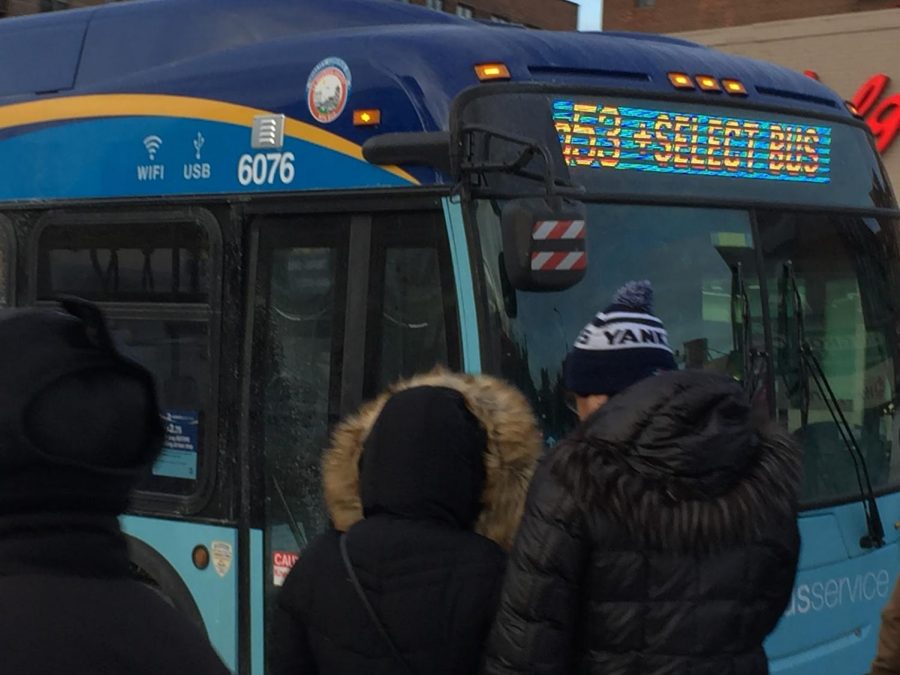How to Fix the MTA
The Q53 is one of the local bus routes that has been recently transformed into a Select Bus Service route.
At the brink of dawn, numerous Bronx Science students arrive on the subway platform of 59th St-Lexington Avenue. Upon what seems like a 24 hour wait, the 4 train arrives while generating a windstorm. Within mere seconds, the train’s interior transforms into a battleground for the competition of limited seats for students to either study, work on homework, or, most likely, sleep.
Despite the crowds that seem to thicken on the platforms, subway ridership has significantly dropped and is still in fact, plummeting. Compared to last year, the number of riders dramatically decreased by 105,000. Above ground, the decline in ridership has been even steeper. The number of people riding the bus this November fell to 1.946 million from 2.927 in November of last year.
MTA authorities interpreted the citizens’ abandonment of the troubled transit system as an indication of the need to modernize public transit quickly.
As a result, they have decided to add “customer service ambassador” positions. Instead of occupying a post behind glass booths, these ambassadors will roam around station entrances and platforms to assist commuters with questions regarding anything from service changes to utilizing MetroCard machines. They will also be equipped with iPhones, which will allow employees to communicate with each other and relay real time updates or any other transit related information to riders. The MTA will prioritize installing such workers in the most foot-trafficked stations, including Times Square, Grand Central and Penn Station.
Although a specific date has not been determined as to when the ambassadors will appear, the contract between the MTA and Transport Workers Union has been recently finalized, thus assuring the arrival of the helpers within 2018. The deal will open 355 ambassador positions to current booth workers. The title even comes with a pay bump of $1 per hour. Not only will riders receive the presumed better quality of customer service, but employees will get access to new, better-paying jobs.
Besides implementing the newfound ambassadors, plastic MetroCards will be traded for an app. Rather than swiping a MetroCard, passengers will wave a smartphone or a credit or debit card. Ultimately, this involves the removal of rusty subway turnstiles in exchange for an advanced fare payment system.
In addition, the MTA plans on pursuing upgrades on more than twenty-one new routes over the next ten years, reaching a half-million more bus riders each day. In particular, these routes will be catered by the Select Bus Service, a system that has been operating since 2008. The program’s aim is to provide a much more efficient and reliable service to local corridors.
“Despite the MTA’s ambitions, they must first prioritize repairing the current flaws within the system.”-Maliha Akter ’18
Despite the MTA’s ambitions, they must first prioritize repairing the current flaws within the system. The decline in ridership is down to two percent; in total, this strains the budget by 45 million dollars. Approximately half of the MTA’s annual budget of 14.6 billion dollars relies on the fares utilized by the riders. Therefore, if the trend of absent customers continues, the budget will shrink to a total of 7 billion dollars. Thus, rather than spending, it is extremely crucial that the transportation system immediately deal with the mechanical failures and track maintenance, which ultimately costs 8 billion dollars.
The Bronx Science student body is divided over such an issue. “Having roaming personnel is a complete waste of money. Commuters don’t rely whatsoever on human interaction; we have metrocard machines, and we have Google maps,” said Issac Rjavinski ’20. On the other hand, Hao Chen ’18 suggests another proposition. “The ambassador position isn’t that bad of an idea, but considering that one of the most frustrating experiences is not being able to know about delays and change in schedules, I believe that a machine is far superior in achieving that goal.”
“I don’t agree with replacing the MetroCard with an app, because not everyone can afford smartphones, and that is totally unnecessary,” Chen ’18 added. The costs of the app and the amount of customers the system would lose would further limit the budget.
“They need to improve upon the existing infrastructure. The current MTA system is unclean and slow compared to public transportation in places in Taiwan and Japan,” noted Chen. “New York City should implement congestion pricing and divert money away from useless and fiscally irresponsible programs in order to pay for a complete repair and overhaul of the metro,” suggested Issac.
If the MTA is not cautious about their expenditures and the declining budget, they may be compelled to implement fare hikes and remove benefits given to senior citizens and students. This includes the possibility of removing Bronx Science’s lifeline, the student MetroCard.
Maliha Akter is a Senior Staff Reporter for ‘The Science Survey’ and the Copy Chief for ‘The Observatory.’ She enjoys journalistic writing because...

